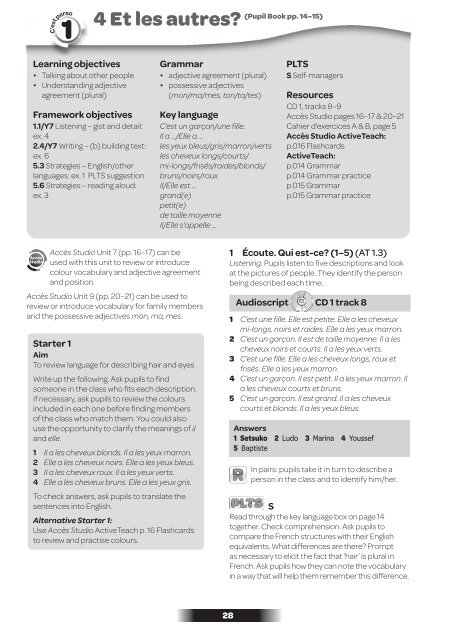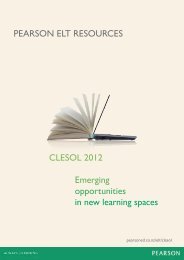Module 1: C'est perso (Pupil Book pp. 6–25) - Pearson
Module 1: C'est perso (Pupil Book pp. 6–25) - Pearson
Module 1: C'est perso (Pupil Book pp. 6–25) - Pearson
You also want an ePaper? Increase the reach of your titles
YUMPU automatically turns print PDFs into web optimized ePapers that Google loves.
pers rs<br />
r o 1 Title<br />
1<br />
<strong>perso</strong><br />
<strong>perso</strong><br />
(Page Nos)<br />
1 Title C’est<br />
C’est<br />
Learning objectives<br />
• Talking about other people<br />
• Understanding adjective<br />
agreement (plural)<br />
Framework objectives<br />
1.1/Y7 Listening – gist and detail:<br />
ex. 4<br />
2.4/Y7 Writing – (b) building text:<br />
ex. 6<br />
5.3 Strategies – English/other<br />
languages: ex. 1 PLTS suggestion<br />
5.6 Strategies – reading aloud:<br />
ex. 3<br />
Accès<br />
Studio<br />
(Page Nos)<br />
(<strong>Pupil</strong> <strong>Book</strong> <strong>pp</strong>. 14–15)<br />
4 Et les autres?<br />
Accès Studio Unit 7 (<strong>pp</strong>. 16–17) can be<br />
used with this unit to review or introduce<br />
colour vocabulary and adjective agreement<br />
and position.<br />
Accès Studio Unit 9 (<strong>pp</strong>. 20–21) can be used to<br />
review or introduce vocabulary for family members<br />
and the possessive adjectives mon, ma, mes.<br />
Starter 1<br />
Aim<br />
To review language for describing hair and eyes<br />
Write up the following. Ask pupils to fi nd<br />
someone in the class who fi ts each description.<br />
If necessary, ask pupils to review the colours<br />
included in each one before fi nding members<br />
of the class who match them. You could also<br />
use the o<strong>pp</strong>ortunity to clarify the meanings of il<br />
and elle.<br />
1 Il a les cheveux blonds. Il a les yeux marron.<br />
2 Elle a les cheveux noirs. Elle a les yeux bleus.<br />
3 Il a les cheveux roux. Il a les yeux verts.<br />
4 Elle a les cheveux bruns. Elle a les yeux gris.<br />
To check answers, ask pupils to translate the<br />
sentences into English.<br />
Alternative Starter 1:<br />
Use Accès Studio ActiveTeach p. 16 Flashcards<br />
to review and practise colours.<br />
Grammar<br />
• adjective agreement (plural)<br />
• possessive adjectives<br />
(mon/ma/mes, ton/ta/tes)<br />
Key language<br />
C’est un garçon/une fi lle.<br />
Il a …/Elle a …<br />
les yeux bleus/gris/marron/verts<br />
les cheveux longs/courts/<br />
mi-longs/frisés/raides/blonds/<br />
bruns/noirs/roux<br />
Il/Elle est …<br />
grand(e)<br />
petit(e)<br />
de taille moyenne<br />
Il/Elle s’a<strong>pp</strong>elle …<br />
28<br />
PLTS<br />
S Self-managers<br />
Resources<br />
CD 1, tracks 8–9<br />
Accès Studio pages 16–17 & 20–21<br />
Cahier d’exercices A & B, page 5<br />
Accès Studio ActiveTeach:<br />
p.016 Flashcards<br />
ActiveTeach:<br />
p.014 Grammar<br />
p.014 Grammar practice<br />
p.015 Grammar<br />
p.015 Grammar practice<br />
1 Écoute. Qui est-ce? (1–5) (AT 1.3)<br />
Listening. <strong>Pupil</strong>s listen to fi ve descriptions and look<br />
at the pictures of people. They identify the <strong>perso</strong>n<br />
being described each time.<br />
Audioscript CD 1 track 8<br />
1 C’est une fi lle. Elle est petite. Elle a les cheveux<br />
mi-longs, noirs et raides. Elle a les yeux marron.<br />
2 C’est un garçon. Il est de taille moyenne. Il a les<br />
cheveux noirs et courts. Il a les yeux verts.<br />
3 C’est une fi lle. Elle a les cheveux longs, roux et<br />
frisés. Elle a les yeux marron.<br />
4 C’est un garçon. Il est petit. Il a les yeux marron. Il<br />
a les cheveux courts et bruns.<br />
5 C’est un garçon. Il est grand. Il a les cheveux<br />
courts et blonds. Il a les yeux bleus.<br />
Answers<br />
1 Setsuko 2 Ludo 3 Marina 4 Youssef<br />
5 Baptiste<br />
In pairs: pupils take it in turn to describe a<br />
<strong>perso</strong>n in the class and to identify him/her.<br />
S<br />
Read through the key language box on page 14<br />
together. Check comprehension. Ask pupils to<br />
compare the French structures with their English<br />
equivalents. What differences are there? Prompt<br />
as necessary to elicit the fact that ‘hair’ is plural in<br />
French. Ask pupils how they can note the vocabulary<br />
in a way that will help them remember this difference.



